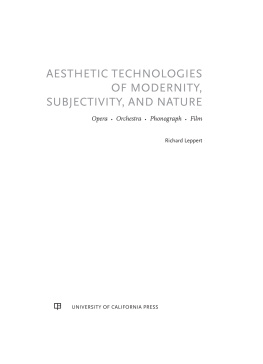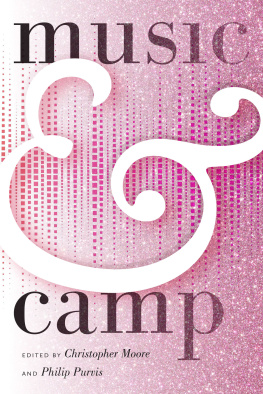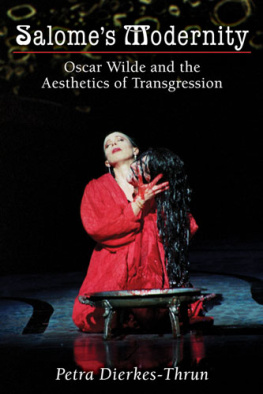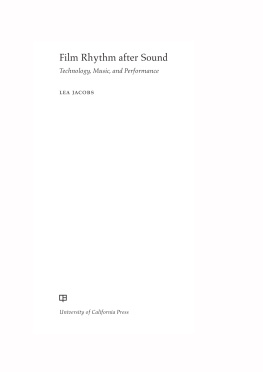ACKNOWLEDGMENTS
I wish to express deepest gratitude to the several colleagues and friends who read various chapters and offered insights, corrections, and encouragement during the long gestation of this project: Hisham Bizri, James Currie, Daniel Goldmark, Helen Greenwald, Berthold Hoeckner, Lawrence Kramer, Charles Kronengold, Sherry Lee, Alice Lovejoy, David M. Lubin, Susan McClary, Jeannie Poole, and Gary Thomas. Peter Franklin and Mitchell Morris patiently read all of it and provided me with a great deal of invariably thoughtful, critical engagement. Joey Crane handled putting all of the musical examples in order; to say the very least, I very much appreciate his attention to detail, timeliness, and skill.
As always, Mary Francis, my long-time editor at the University of California Press, provided invaluable advice and moral support throughout the six years of the books gestation; to her I owe a special note of gratitude. Anne Canright, who copy-edited the manuscript, was attentive to the smallest detail and, in that regard, saved me from more than a few embarrassing lapses. Bradley Depew and Rose Vekony saw to all the details of putting the book into print.
The staff support at the University of Minnesota Libraries was, as ever, professional, tireless, and cheerful, and no matter the numbers of requests for closed-stacks materials. Im deeply grateful kind assistance provided by John Pennino, Archivist for the Metropolitan Opera, and the several staff assistants in the New York Public Librarys Billy Rose Theatre Division at Lincoln Center.
Chapters 1, 2, and 4 are based on the following previously published essays; they have been revised and expanded for inclusion in this volume:
The Civilizing Process: Music and the Aesthetics of Time-Space Relations in The Girl of the Golden West. In Musical Meaning and Human Values, ed. Keith Chapin and Lawrence Kramer, 11750, 20317. New York: Fordham University Press, 2009.
Opera, Aesthetic Violence, and the Imposition of Modernity: Fitzcarraldo. In Beyond the Soundtrack: Representing Music in Cinema, ed. Daniel Goldmark, Lawrence Kramer, and Richard Leppert, 99119. Berkeley: University of California Press, 2007.
Two Notes, One Ending (Three Operas) at the Boundary of the Great Divide; or, Aesthetic Meanderings of the Sonic Psyche. Opera Quarterly 31, nos. 12 (2015): 7199.
INTRODUCTION
This is a book about music, opera especially, the phonograph, and cinema centered on questions concerning modernity, subjectivity, and nature emerging in the years immediately preceding 1910 and following in the next decade or so thereafter. The cultural practices of my concern either date from those years (three chapters) or are constituted by late-twentieth-century looking back at that time period. Along the way, I pause the main narrative to take up related issues in two freestanding excurses. Ill characterize the subject matter of the individual chapters and excurses in due course.
The governing idea for what follows developed over a number of years, but the seed for it was a well-known (at least to literary scholars) text by Virginia Woolf, writing in 1924, where she noted: On or about December, 1910, human character changed.research), and the result is this volume, the totality of which at times moves quite far beyond this opera, regarding which I would be less than frank were I to assume that the connective tissue shared by the chapters and excurses will seem entirely evident simply by the names Ive given to each of them. However, if Ive succeeded in the task I set for myself, by the time you finish reading what follows, the historical, social, cultural, and aesthetic homologies should be clear. Individually or taken together, in any event, Im confident that the cultural artifacts and practices Ive considered are historically and culturally significant: that much as the minimum.
Woolfs concern in 1924 (coincidentally the year of Puccinis death) looking back to 1910 was the changing state of English literature, which faced new aesthetic demands in the twentieth century; in brief, her concern was modernism. Writers, as she put it, tried to compromise (like Puccini, of which more later), but compromise wasnt up to literatures cultural task. And so, she wrote, the smashing and the crashing began. And here, though speaking about literature, Woolf provides a vivid series of explicitly sonic metaphors that mark quasi-epistemic cultural change: Thus it is that we hear all round us,... the sound of breaking and falling, crashing and destruction. It is the prevailing sound of the Georgian agerather a melancholy one if you think what melodious days there have been in the past... if you think of the language, and the heights to which it can soar when free, and see the same eagle [now] captive, bald, and croaking.
Taking a different but related tack a few years later, the Futurist (later fascist) poet F. T. Marinetti celebrated modern noise as the fitting harbinger for a modernism allegorized in this instance as an apotheosis of violence. He wrote to his friend and fellow Futurist Luigi Russolo about the sonorities of what he had heard at the battle of Adrianapolis, Turkey, in October 1912. In an orgasmic ecstasy of words piled atop one another, he took unambiguous pleasure in the sonic (and olfactory) chaos that gave him pleasure as music: What a joy to hear to smell completely taratatata of the machine guns screaming a breathlessness under the stings slaps traak-traak whips pic-pac-pum-tumb weirdness leaps 200 meters range Far far in back of the orchestra pools muddying hyffing goaded oxen wagons. To which Russolo drily responded, We want to give pitches to these diverse noises, regulating them harmonically and rhythmically.








